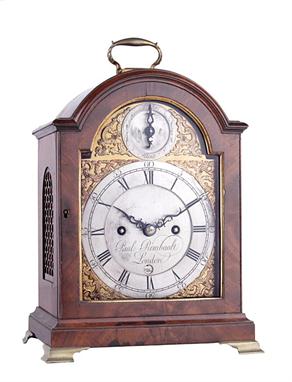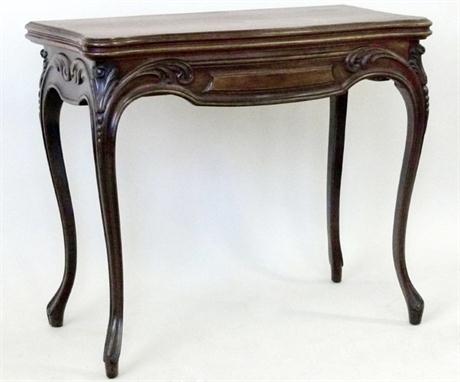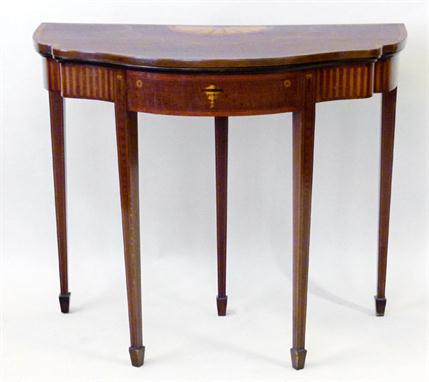We found 1181390 price guide item(s) matching your search
There are 1181390 lots that match your search criteria. Subscribe now to get instant access to the full price guide service.
Click here to subscribe- List
- Grid
-
1181390 item(s)/page
A George III brass mounted fruitwood quarter-chiming table clock Robert Henderson, London circa 1775 The six pillar triple fusee movement with verge escapement, chiming the quarters on a nest of eight graduated bells and striking the hour on a further larger bell, the backplate engraved with symmetrical strapwork and foliate scrolls around a central basket motif with pendulum holdfast hook beneath, the 7 inch brass break-arch dial with shaped recessed silvered signature plate engraved RobÕt Henderson, London and calendar aperture to the matted centre within applied silvered Roman numeral chapter ring with Arabic five minutes to outer track and scroll pierced blued steel hands, the angles with rococo scroll cast spandrels beneath arch centred with a subsidiary Strike/Silent dial flanked by conforming mounts, the bell top case with scroll pierced frets flanking pedestal surmount capped with a pineapple finial above brass festoon applied collar and four further finials to superstructure, over front with scroll cast upper quadrant frets and fillet inset glazed dial aperture to door flanked by cast female caryatid applied canted angles, the sides with generous hinged carrying handles above conforming concave topped rectangular side windows, on moulded shallow skirt base with foliate scroll cast bracket feet, 58cm (23ins) high overall. Robert Henderson is recorded in Baillie, G.H. Watchmakers & Clockmakers of the World as working in London 1768-1805, Baillie further notes that a musical clock by Henderson is in the ÔPeipingÕ Museum collection.
A George III small mahogany table clock Paul Rimbault, London, circa 1800 The five pillar twin chain fusee bell striking movement signed Paul Rimbault, London to the scroll border engraved backplate, the 6 inch brass break-arch dial with repeat signature and circular calendar aperture to the silvered centre within applied Roman numeral chapter ring with Arabic five minutes to outer track and scroll cast lacquered brass spandrels to angles beneath arch with subsidiary Strike/Silent dial flanked by conforming mounts, the break-arch case with brass carrying handle above brass fillet inset front door aperture and arched brass fishscale sound frets to sides, on moulded skirt base with brass bracket feet, 31cm (12ins) high excluding handle. Paul Rimbault is recorded in Baillie G.H. Watchmakers & Clockmakers of the World as working from Denmark Street, London 1770-85.
A George III ebonised table clock Thomas Pepys, London, circa 1775 The five pillar twin fusee bell striking movement with verge escapement and symmetrical foliate scroll engraved backplate, the 8 inch brass break-arch dial with calendar aperture and shaped recessed silvered signature plaque engraved Thomas Pepys, London to the matted centre within applied silvered Roman numeral chapter ring with Arabic five minutes and scroll pierced blued steel hands, the angles applied with scroll cast spandrels beneath arch centred with subsidiary STRIKE/SILENT dial flanked by conforming mounts, the bell-top case with brass carrying handle above foliate scroll pierced quadrant frets and raised mouldings to dial aperture flanked by caddy moulded angles to front, the sides with circular over concave topped windows, on cavetto moulded shallow skirt base with brass bracket feet, 49cm (19.25ins) high. Thomas Pepys is recorded in Baillie G.H. Watchmakers & Clockmakers of the World as working in London from circa 1740.
A George III mahogany table clock Thomas Crowdhill, London, circa 1790 The five pillar twin fusee bell striking movement with symmetrical foliate scroll engraved backplate and 7 inch silvered brass break-arch Roman numeral dial with calendar aperture and signature Crowdhill, LONDON to centre and Arabic five minutes to outer track, the angles with foliate scroll engraved decoration with the upper continuing into the arch to border the subsidiary STRIKE/SILENT dial above, the bell top case with hinged brass carrying handle and pinecone finials above brass-fillet inset front door with scroll cast frets to upper quadrants, the sides with brass grille inset break-arch sound frets, on cavetto moulded skirt base with bracket feet, 48cm (19ins) high excluding handle. Thomas Crowdhill is recorded in Baillie, G.H. Watchmakers & Clockmakers of the World as working in London circa 1790.
A George III brass mounted mahogany table clock with alarm for the Iberian market John Walker, London, circa 1800 The five pillar twin fusee bell striking movement with original anchor escapement with wide T bar suspension for the engraved lenticular bob pendulum and pull-wind alarm sounding on the hour bell, the backplate signed John Walker, London to a leafy trail border engraved oval reserve, the 8 inch arched white painted Roman numeral dial inscribed JOHN WALKER, GLOUCESTER STREET, LONDON to centre and with pierced gilt hands, the angles with raised gilt painted floral sprays beneath arch with triple subsidiary dials for calendar, alarm setting and BATER/SILENCIO selection, the break-arch case with concave sided pyramid upstand incorporating scroll pierced brass fret infill above brass fillet inset glazed dial aperture to front door flanked by cast female caryatid mounted canted angles, the sides with hinged brass handles over arched lattice-pierced brass sound frets, on moulded skirt base with brass bracket feet, 61cm (24ins) high overall. A John Walker is recorded in Britten, F.J. OLD CLOCKS AND WATCHES & THEIR MAKERS as working from 29 Gloucester Street, QueenÕs Square, London in 1816.
A fine William and Mary small ebony table timepiece with silent-pull quarter repeat and alarm Willaim Cattell, London, circa 1690 The seven finned pillar single fusee movement with verge escapement, silent-pull quarter repeat on two bells and alarm sounding on the smaller of the two, the symmetrical foliate scroll engraved backplate signed William Cattell, Londini fecit to a central shaped cartouche beneath leafy spray engraved and pierced backcock apron, the 6 inch square gilt brass dial with silvered alarm disc and single winding hole to the matted centre within applied silvered Roman numeral chapter ring with stylised fleur-de-lys half hour markers and Arabic five minutes within the narrow outer track, the angles applied with gilt winged cherub head cast spandrels, the case with unusual gilt brass hinged carrying handle to the domed caddy surmount above complex top mouldings and foliate scroll pierced elongated lozenge shaped sound fret to the upper rail of the front door, the dial aperture with raised edge mouldings and with gilt cherub head and scroll cast escutcheon mounts to uprights, the sides with break-arch glazed side apertures, on conforming shallow skirt base with squab feet, 32cm (12.5ins) high. Provenance: The property of a private collector, formerly the property of Major Frederick Lord Aldersley Packman (1865-1944), a manuscript inventory of his collection included in the lot records the clock being gifted in February 1939, unfortunately the name of the individual who received the clock is indistinctly entered. William Cattell is recorded in Loomes, Brian The Early CLOCKMAKERS of Great Britain as apprenticed1664/5 to Edward Stanton and gaining his Freedom of the ClockmakersÕ Company in April 1672. He worked from Fleet Street and took his son, Thomas, as an apprentice in 1681. Loomes notes that William Cattell was not heard of later than 1687 and suggests that he died prior to 1697. The current lot is designed to sound the hours and quarters on two bells only on demand. This form of quarter repeat mechanism is thought to have been devised for night-time use in the bedroom; whilst striking clocks with quarter repeat facility were generally intended to be utilised downstairs during the day and upstairs at night. As a consequence silent-pull quarter repeating timepieces are rarer as the original owner have to have been extremely wealthy to afford a timepiece reserved exclusively for use in the bed chamber; especially one that was also fitted with an alarm mechanism. The current lot is extensively illustrated in ANTIQUARIAN HOROLOGY Volume 25 number 2 pages 202-3. These illustrations clearly show the repeat mechanism which is closely related to the system used by Joseph Knibb as described and illustrated in Allix, Charles and Harvey, Laurence HOBSONÕS CHOICE pages 36-7..
An extremely rare Queen Anne Chinese lacquer eight-day longcase clock Daniel Delander, London, early 18th century The five finned pillar rack and bell striking movement with 12 inch square brass dial with subsidiary seconds dial, calendar aperture and silvered oval plate signed Dan. Delander, London to the matted centre within applied silvered Roman numeral chapter ring with fleur-de-lys half hour markers and Arabic five minutes to outer track, the angles with gilt Indian mask and scroll cast spandrels, in a case with flambeau urn finials and tall caddy decorated in raised polychrome and gilt with flowering foliage above scroll pierced fret to upstand over moulded cornice and conforming fret to frieze and three-quarter columns with brass caps and bases flanking raised foliate spray decoration to the glazed hood door, the trunk with silvered leafy-scroll carved wood decorative corbels to throat above door finely decorated in raised polychrome and gilt with birds and a mallard in flight near a blossoming shrub issuing from a rocky outcrop with two standing crane birds, the sides with particularly fine relief gnarled tree trunk decoration issuing leafy sprays, on plinth base further decorated with aquatic birds within a naturalistic setting over moulded double skirt with squab feet, 254cm (100ins) high excluding top finial, 269 (106ins) high overall. Daniel Delander is recorded in Loomes, Brian The Early CLOCKMAKERS of Great Britain as born circa 1678 and apprenticed to Charles Halstead before being transferred to Thomas Tompion and gaining his Freedom of the ClockmakersÕ Company in 1699. He initially worked as ÔservantÕ to Thomas Tompion from Devereux Court and later (after TompionÕs death in 1713) from Ôwithin Temple BarÕ, Fleet Street. He was a fine maker whose work was clearly influenced by his master but is perhaps best known for his series of particularly fine duplex escapement longcase clocks as well as long duration clocks often with refinements such as equation of time. Delander appeared to also share his masterÕs exacting standards with regards to the quality and design of the cases for his clocks, with his table clocks often mirroring those of Tompion and his successor George Graham. The case of the current lot appears to be an extremely rare, if not an unique surviving example of Chinese lacquer decoration applied to a case made in London. The construction of the case is typical of English work of this period however differs in that the carcass is made almost entirely of pine (only the cleats in the trunk door appear to be oak) rather than being of the usual mixed pine/oak for ÔjapannedÕ cases. This departure from the use of oak for any of the surfaces/principal structural elements of the current lot supports the view that the case was designed to be shipped to China for decoration; indeed accounts exist confirming that deal timber was sent to China as it was deemed well suited for lacquer work (see Bowett, Adam ENGLISH FURNITURE 1660-1714 page 149). The decoration itself is of fine quality with every element formed in relief built-up using a hard brick-red coloured clay based lacquer compound (rather than white gesso) indicative of Chinese/Japanese practice. The design is relatively restrained and is principally composed of naturalistic asymmetric forms contrasting with delicate blossom detail inhabited by birds. This slightly restrained approach perhaps displays a Japanese influence however such work during this period was only undertaken in China; it is perhaps appropriate that the trunk door is decorated with a pair of crane birds which are deemed a symbol of longevity in Chinese culture. We would like to thank Adam Bowett for his assistance with the footnote for this lot.
A mixed dozen bottles of wine comprising: 1 x Merlot Della Venezie 1998; 2 x Dom Gregoire Carte D`Or; 1 x Bonneval Mousseaux; 1 x Don Darius Red; 1 x Miral Campo Rioja; 1 x Frogmore English Table Wine 1984; 1 x Sainsbury`s 2003 Soave Colli Scaligen; 1 x KWV Pinotage, South Africa 1991; 1 x Pinot Classico White Wine, Malta; 1 x Marques del Romeral, Marks & Spencer, 1976 Rioja; 1 x Senorio de Sarria, Navarra, Spain, 1978
Glass vase shaped table lamp in the style of Tiffany Favrile decorated with an orange iridescent overlay finish on a white body, the base drilled for a wire, together with brass fittings, Ovington`s New York label to base, the vase measures 41cm high without the fittings. Condition report: No damage or restoration.
Six silver apostle spoons , import markLondon 1890 , with fancy cast hilts; two George III silver fiddle pattern table spoons ; eight old English teaspoons , Alexander Henderson, Edinburgh 1805 ; two teaspoons by PAW Bateman ; three fancy silver bladed fish knives with shell handles, 18oz 5dwt weighable.
Part suite of silver old English flatware , Josiah Williams, London 1894 , consisting of: eleven table forks, eleven dessert forks, twelve egg spoons, six teaspoons, four mustard spoons, twelve table spoons, twelve dessert spoons, two sauce ladles, a sifter spoon, soup ladle, condiment spoon and an odd soup spoon, 135oz 2dwt in total, together with its oak table top canteen (knives lacking).
Set of twelve silver fiddle pattern table forks , Wm Jamieson of Aberdeen, Edinburgh 1838 ; five oar patterntable spoons, Edinburgh 1811 ; four fiddledessert spoons ,Rettie & Son of Aberdeen, Edinburgh 1811 ; two Victorian Edinburghtoddy ladles and five other spoons , 46oz 2dwt in total.
-
1181390 item(s)/page

























































